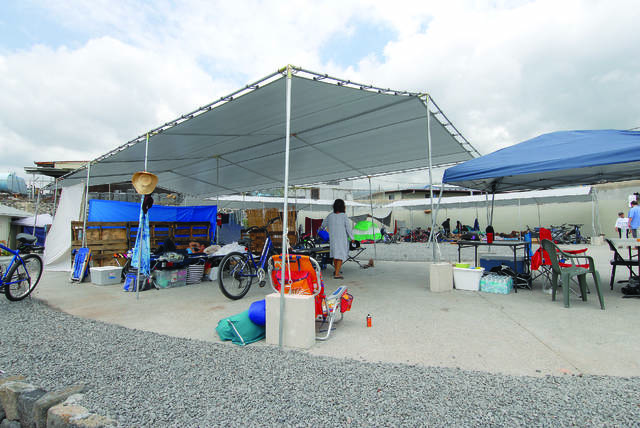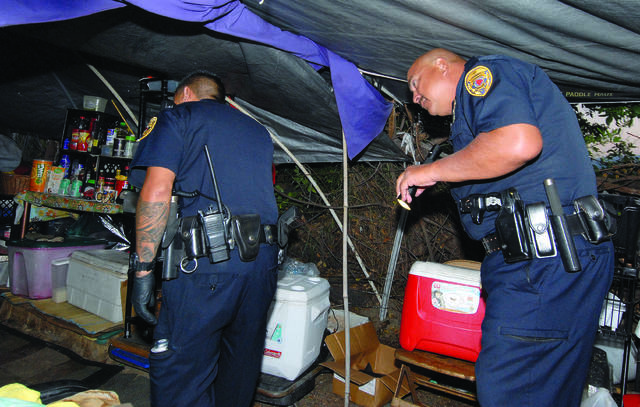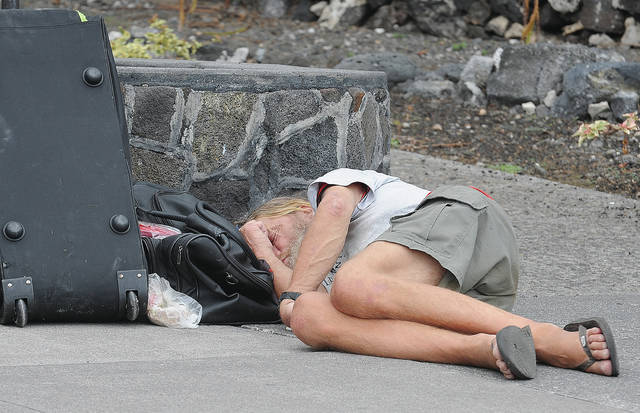State of emergency: Governor issues proclamation to get Ohana Zone initiative rolling




KAILUA-KONA — Just days into his second term, Gov. David Ige is acting quickly to implement a new program designed to combat one of Hawaii’s most crippling, hard-to-manage problems — homelessness.
KAILUA-KONA — Just days into his second term, Gov. David Ige is acting quickly to implement a new program designed to combat one of Hawaii’s most crippling, hard-to-manage problems — homelessness.
The governor announced Friday he’d signed an emergency proclamation to fast-track the state’s new Ohana Zone initiative, approved by the Legislature last session. The program will spread $30 million to at least three projects on Oahu and one project per neighbor island as Hawaii attempts to gain momentum in its struggle with homelessness.
“I did, this morning, sign an emergency proclamation to really help facilitate and accelerate our efforts in providing housing for those most vulnerable in our communities, those who are homeless,” Ige said at a press conference.
The proclamation will put $17 million quickly into action, mostly for work on Oahu where there is considerably more established infrastructure to combat the problem.
“Our strategy is to utilize existing facilities that are already in place so that we’re able to really hit the ground running with Ohana Zone funds to get projects out in the community as quickly as we can,” said Scott Morishige, the governor’s coordinator on homelessness. “Because we know that there’s a great need, we want to be able to address that as quickly as possible with the resources that have been provided to us.”
Immediate action on Hawaii Island will be limited to The Homes at Ulu Wini, a housing project off Hina Lani Street in Kona. A total of 23 units will be converted, 10 to emergency shelters for families that could handle up to six people per unit and 13 to permanent supportive housing.
Roy Takemoto, executive assistant to Hawaii County Mayor Harry Kim, told West Hawaii Today in May that units at Ulu Wini are currently backed by Section 8 funding. Converting the 13 units with Ohana Zone money frees up those Section 8 monies for use elsewhere.
As to the other $13 million in Ohana Zone funding, Kim and Takemoto are hoping to secure annual backing for their idea for a long-term, multi-acre homeless housing initiative off Kealakehe Parkway dubbed Village 9 and its yet-to-be-named Hilo counterpart.
“We are in active discussion with the Governor’s office to tap into some of the available balance of Ohana funds for Village 9 and an East Hawaii site,” Takemoto wrote in a text message Friday. “The counties are working together so that we all have equal shares relative to need. We will be kicking off the master planning for Village 9 in January.”
History of homelessness
While numbers have dropped across the state in each of the last two years, according to inexact point-in-time count studies conducted annually in each county, Hawaii yet retains the dubious honor of leading the country in per capita homelessness.
The proliferation of the homeless, which continued unfettered for nearly a decade until 2016, brought with it several social and economic problems. In Kona, those impacts have most noticeably been irked business owners who say the homeless presence frightens and agitates visitors, disrupting tourism commerce that is far and away the county’s largest revenue source. There’s also been the frequent cropping up of tent cities in public spaces.
Ige was quick to delineate between Ohana Zones and informal congregations of homeless — such as the one that developed over time at Old Kona Airport Park and sent dozens of individuals back onto Alii Drive and into the Old Industrial Area when police dispersed the illegal campers.
“An Ohana Zone is not the same as a safe zone or a tent city,” Ige said. “We know that tent cities are not effective in addressing homelessness because often times they’re not accompanied by … support services, which we know is fundamentally important to supporting moving homeless individuals into permanent housing.”
Support services in the context of the governor’s comments are resources like mental health treatment and drug rehabilitation, problems that often characterize those classified as chronically homeless whom the state will prioritize in its Ohana Zone projects under the federal Housing First model.
Also with the surge in homelessness came an increase in petty crimes and a public health crisis that drains Hawaii’s annual Medicaid funds. Then-senator and now Lt. Gov. Josh Green, who represented Kona in the Legislature, advocated in 2017 to classify homelessness as a medical condition.
His thoughts were to use some of the roughly $2 billion in Medicaid the state receives each year and divert it to providing housing and support services to chronically homeless, stemming the stream of emergency room visits.
The University of Hawaii at Manoa conducted a study in recent years that identified a 43 percent dip in the cost of health care for homeless who were provided six months of consistent housing.
At the end of November, the federal government granted Hawaii approval to divert some of its Medicaid funding to homelessness initiatives. As to how much the feds will allow and how much the state will allocate, that is “not determined yet,” Green wrote in a text message.
“We’re going to get a lot more bang for our buck,” Green said at the press conference. “We will see a decrease in utilization of Medicaid dollars because we’ll be helping the (people) hardest to take care of.”
As to crime, bumps in vandalism, property crimes, trespassing and theft have been noted by business owners in Kona’s Old Industrial Area. Specifically, they’ve mentioned increased activity in front of HOPE Services’ campus, which includes an emergency shelter, the Friendly Place, which serves meals and offers other services, and Hale Kikaha.
Hale Kikaha was West Hawaii’s response to Ige’s last emergency proclamation on homelessness, which came in late 2015. It created a community of micro-housing units made from converted shipping containers to pull some of Kona’s most at-risk homeless off the street.
When the county in the summer of 2017 made it clear to the homeless that the Old Airport was off limits, several dozen evacuees moved into a lot next to Hale Kikaha dubbed Camp Kikaha, where they resided for several months as the county placed as many as it could into transitional housing.
After the county could no longer afford to support the camp, it was disbanded. However, not all the homeless have dispersed, which has complicated issues for HOPE Services and area businesses.
Green said in a text it’s possible that funding for increased security measures at the site could be made available from the Ohana Zone general fund.



Homelessness is a government mandated project to drain the purses of the Middle Class.
Government mandated? You are so wrong.
Can you elaborate?
Actually it is you that needs to elaborate, or perhaps clarify your statement , which I claimed as false. Can you demonstrate how, in fact, ‘Homelessness is government mandated… ‘?
May be a poor choice of word but you might agree the government want to run every aspect of everyone’s life and then make us responsible for other peoples bad life choices.
Let me run this by you J when has our government Federal or local ever fixed a problem and called it finished.
If you do a little research, you will be amazed how many cities are building multi-million dollar homelessness centers filled with bureaucrats that administer homelessness activities. And guess who is paying for these? The Middle-Class taxpayer. The middle-class is under pressure from above and below, and has been ever since Karl Marx published the Communist Manifesto. In it he stated “From each according to his ability, to each according to his need.”
Now do you understand it?
You are so wrong, we are not required to pay for these people. Sad yes but it is not our responsibility! Nor the Federal Governments.
the issue is that these people have no desire to work they figure the world owes them a living –while most of us have worked hard all of our lives just to be confronted with these freeloaders ship them out to where there came from–so if your as a senior cannot pay your rent your out on the streets after working 45 years in the system why should THEY GET A BREAK WHEN I NEVER HAD